Project: Child Development Environment and Activities
VerifiedAdded on 2020/09/09
|5
|1720
|173
Project
AI Summary
This project delves into the multifaceted aspects of facilitating and enhancing children's development within an educational setting. It emphasizes the importance of creating a safe and stimulating environment, including appropriately sized and safe equipment, and addressing any potential hazards. The project outlines the significance of providing diverse and challenging learning opportunities through a range of activities, such as group activities, individual milestones, hands-on sensory experiences, and free play, all tailored to be age-appropriate and aligned with child development milestones. The project highlights the educator's role in encouraging children's involvement and participation by asking questions, participating in activities, and documenting observations to inform future activities. Furthermore, it explores methods of observation and documentation, including child-centered discussions, work samples, and family interviews, to gather comprehensive information about each child's interests, abilities, and needs. The project also covers planning, implementing, and evaluating experiences, ensuring the learning curriculum is guided by children's interests and needs, and adapting experiences based on age, abilities, culture, and individual needs. Contingency planning is addressed to accommodate unplanned child-initiated play and unexpected events. Finally, the project emphasizes the importance of sustainability, including waste management practices within the daily routine and activities.
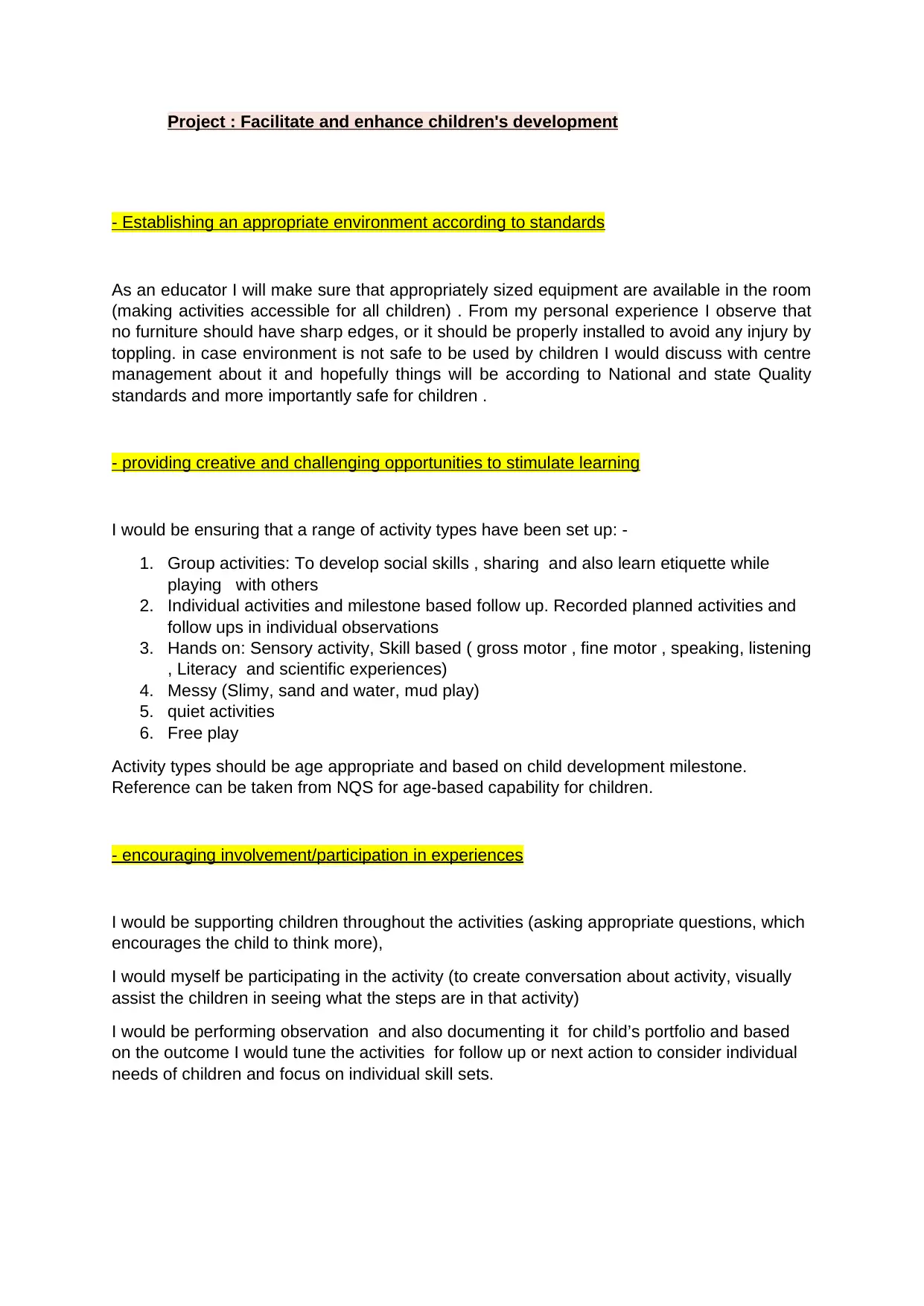
Project : Facilitate and enhance children's development
- Establishing an appropriate environment according to standards
As an educator I will make sure that appropriately sized equipment are available in the room
(making activities accessible for all children) . From my personal experience I observe that
no furniture should have sharp edges, or it should be properly installed to avoid any injury by
toppling. in case environment is not safe to be used by children I would discuss with centre
management about it and hopefully things will be according to National and state Quality
standards and more importantly safe for children .
- providing creative and challenging opportunities to stimulate learning
I would be ensuring that a range of activity types have been set up: -
1. Group activities: To develop social skills , sharing and also learn etiquette while
playing with others
2. Individual activities and milestone based follow up. Recorded planned activities and
follow ups in individual observations
3. Hands on: Sensory activity, Skill based ( gross motor , fine motor , speaking, listening
, Literacy and scientific experiences)
4. Messy (Slimy, sand and water, mud play)
5. quiet activities
6. Free play
Activity types should be age appropriate and based on child development milestone.
Reference can be taken from NQS for age-based capability for children.
- encouraging involvement/participation in experiences
I would be supporting children throughout the activities (asking appropriate questions, which
encourages the child to think more),
I would myself be participating in the activity (to create conversation about activity, visually
assist the children in seeing what the steps are in that activity)
I would be performing observation and also documenting it for child’s portfolio and based
on the outcome I would tune the activities for follow up or next action to consider individual
needs of children and focus on individual skill sets.
- Establishing an appropriate environment according to standards
As an educator I will make sure that appropriately sized equipment are available in the room
(making activities accessible for all children) . From my personal experience I observe that
no furniture should have sharp edges, or it should be properly installed to avoid any injury by
toppling. in case environment is not safe to be used by children I would discuss with centre
management about it and hopefully things will be according to National and state Quality
standards and more importantly safe for children .
- providing creative and challenging opportunities to stimulate learning
I would be ensuring that a range of activity types have been set up: -
1. Group activities: To develop social skills , sharing and also learn etiquette while
playing with others
2. Individual activities and milestone based follow up. Recorded planned activities and
follow ups in individual observations
3. Hands on: Sensory activity, Skill based ( gross motor , fine motor , speaking, listening
, Literacy and scientific experiences)
4. Messy (Slimy, sand and water, mud play)
5. quiet activities
6. Free play
Activity types should be age appropriate and based on child development milestone.
Reference can be taken from NQS for age-based capability for children.
- encouraging involvement/participation in experiences
I would be supporting children throughout the activities (asking appropriate questions, which
encourages the child to think more),
I would myself be participating in the activity (to create conversation about activity, visually
assist the children in seeing what the steps are in that activity)
I would be performing observation and also documenting it for child’s portfolio and based
on the outcome I would tune the activities for follow up or next action to consider individual
needs of children and focus on individual skill sets.
Paraphrase This Document
Need a fresh take? Get an instant paraphrase of this document with our AI Paraphraser
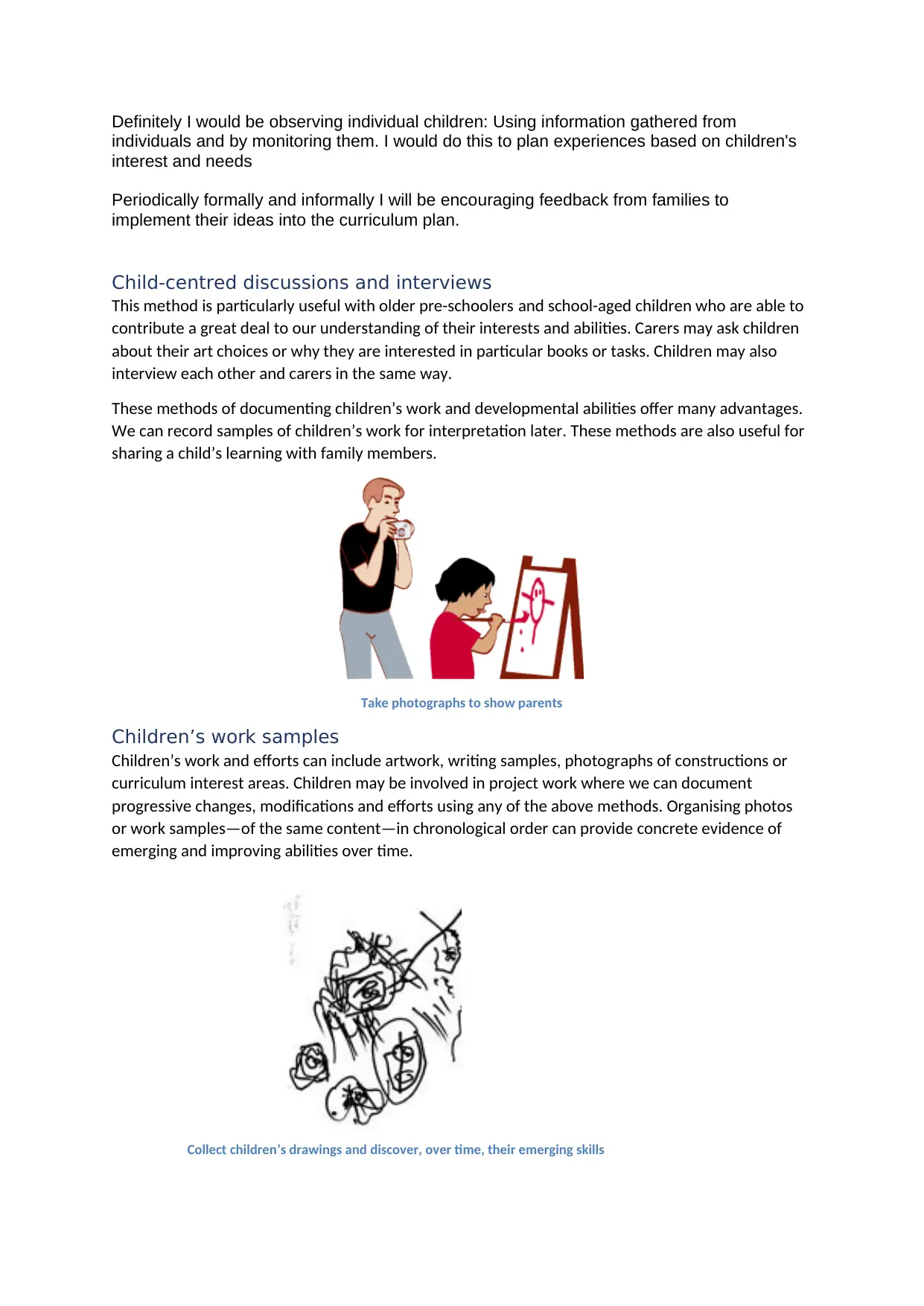
Definitely I would be observing individual children: Using information gathered from
individuals and by monitoring them. I would do this to plan experiences based on children's
interest and needs
Periodically formally and informally I will be encouraging feedback from families to
implement their ideas into the curriculum plan.
Child-centred discussions and interviews
This method is particularly useful with older pre-schoolers and school-aged children who are able to
contribute a great deal to our understanding of their interests and abilities. Carers may ask children
about their art choices or why they are interested in particular books or tasks. Children may also
interview each other and carers in the same way.
These methods of documenting children’s work and developmental abilities offer many advantages.
We can record samples of children’s work for interpretation later. These methods are also useful for
sharing a child’s learning with family members.
Take photographs to show parents
Children’s work samples
Children’s work and efforts can include artwork, writing samples, photographs of constructions or
curriculum interest areas. Children may be involved in project work where we can document
progressive changes, modifications and efforts using any of the above methods. Organising photos
or work samples—of the same content—in chronological order can provide concrete evidence of
emerging and improving abilities over time.
Collect children’s drawings and discover, over time, their emerging skills
individuals and by monitoring them. I would do this to plan experiences based on children's
interest and needs
Periodically formally and informally I will be encouraging feedback from families to
implement their ideas into the curriculum plan.
Child-centred discussions and interviews
This method is particularly useful with older pre-schoolers and school-aged children who are able to
contribute a great deal to our understanding of their interests and abilities. Carers may ask children
about their art choices or why they are interested in particular books or tasks. Children may also
interview each other and carers in the same way.
These methods of documenting children’s work and developmental abilities offer many advantages.
We can record samples of children’s work for interpretation later. These methods are also useful for
sharing a child’s learning with family members.
Take photographs to show parents
Children’s work samples
Children’s work and efforts can include artwork, writing samples, photographs of constructions or
curriculum interest areas. Children may be involved in project work where we can document
progressive changes, modifications and efforts using any of the above methods. Organising photos
or work samples—of the same content—in chronological order can provide concrete evidence of
emerging and improving abilities over time.
Collect children’s drawings and discover, over time, their emerging skills
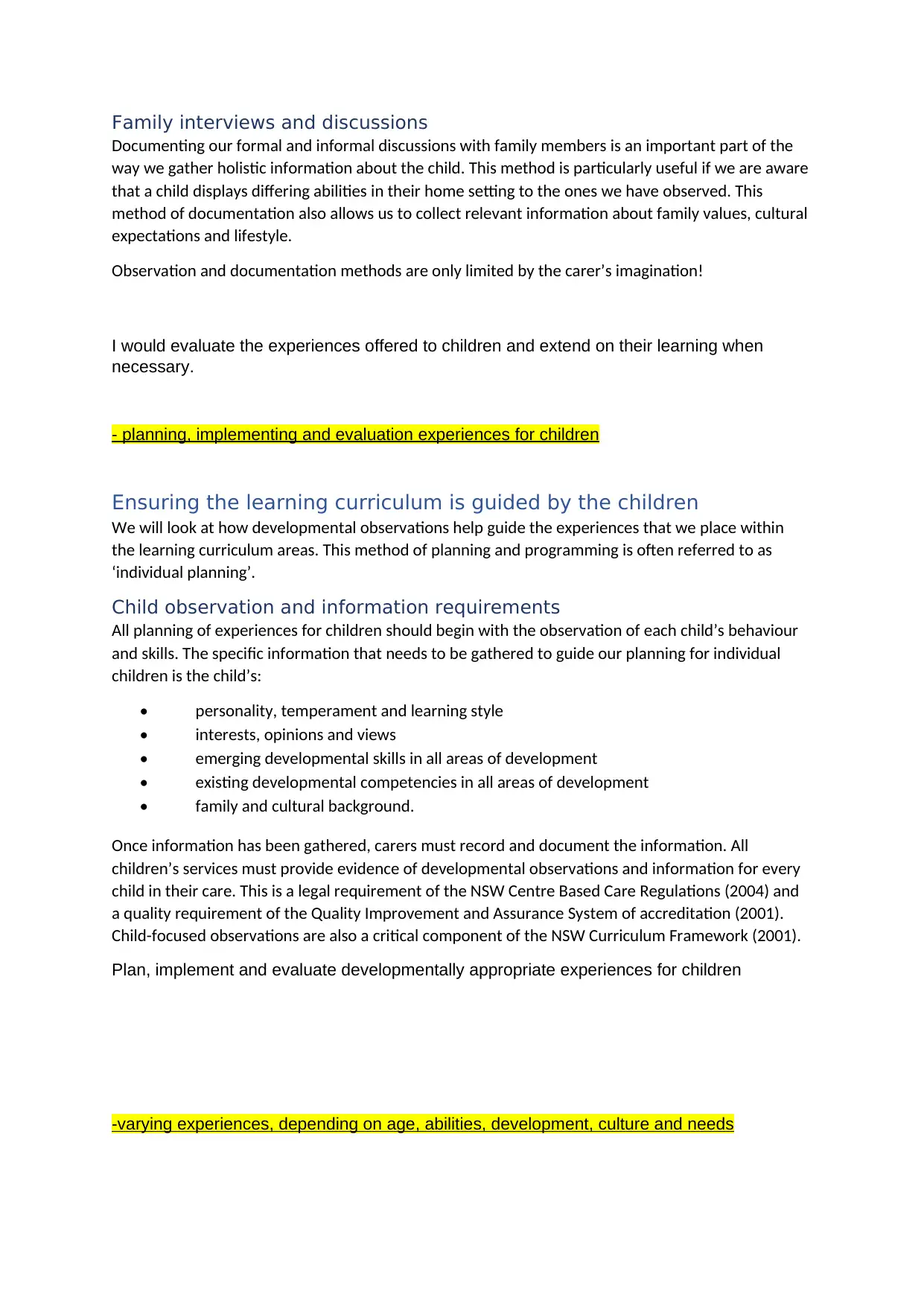
Family interviews and discussions
Documenting our formal and informal discussions with family members is an important part of the
way we gather holistic information about the child. This method is particularly useful if we are aware
that a child displays differing abilities in their home setting to the ones we have observed. This
method of documentation also allows us to collect relevant information about family values, cultural
expectations and lifestyle.
Observation and documentation methods are only limited by the carer’s imagination!
I would evaluate the experiences offered to children and extend on their learning when
necessary.
- planning, implementing and evaluation experiences for children
Ensuring the learning curriculum is guided by the children
We will look at how developmental observations help guide the experiences that we place within
the learning curriculum areas. This method of planning and programming is often referred to as
‘individual planning’.
Child observation and information requirements
All planning of experiences for children should begin with the observation of each child’s behaviour
and skills. The specific information that needs to be gathered to guide our planning for individual
children is the child’s:
• personality, temperament and learning style
• interests, opinions and views
• emerging developmental skills in all areas of development
• existing developmental competencies in all areas of development
• family and cultural background.
Once information has been gathered, carers must record and document the information. All
children’s services must provide evidence of developmental observations and information for every
child in their care. This is a legal requirement of the NSW Centre Based Care Regulations (2004) and
a quality requirement of the Quality Improvement and Assurance System of accreditation (2001).
Child-focused observations are also a critical component of the NSW Curriculum Framework (2001).
Plan, implement and evaluate developmentally appropriate experiences for children
-varying experiences, depending on age, abilities, development, culture and needs
Documenting our formal and informal discussions with family members is an important part of the
way we gather holistic information about the child. This method is particularly useful if we are aware
that a child displays differing abilities in their home setting to the ones we have observed. This
method of documentation also allows us to collect relevant information about family values, cultural
expectations and lifestyle.
Observation and documentation methods are only limited by the carer’s imagination!
I would evaluate the experiences offered to children and extend on their learning when
necessary.
- planning, implementing and evaluation experiences for children
Ensuring the learning curriculum is guided by the children
We will look at how developmental observations help guide the experiences that we place within
the learning curriculum areas. This method of planning and programming is often referred to as
‘individual planning’.
Child observation and information requirements
All planning of experiences for children should begin with the observation of each child’s behaviour
and skills. The specific information that needs to be gathered to guide our planning for individual
children is the child’s:
• personality, temperament and learning style
• interests, opinions and views
• emerging developmental skills in all areas of development
• existing developmental competencies in all areas of development
• family and cultural background.
Once information has been gathered, carers must record and document the information. All
children’s services must provide evidence of developmental observations and information for every
child in their care. This is a legal requirement of the NSW Centre Based Care Regulations (2004) and
a quality requirement of the Quality Improvement and Assurance System of accreditation (2001).
Child-focused observations are also a critical component of the NSW Curriculum Framework (2001).
Plan, implement and evaluate developmentally appropriate experiences for children
-varying experiences, depending on age, abilities, development, culture and needs
⊘ This is a preview!⊘
Do you want full access?
Subscribe today to unlock all pages.

Trusted by 1+ million students worldwide
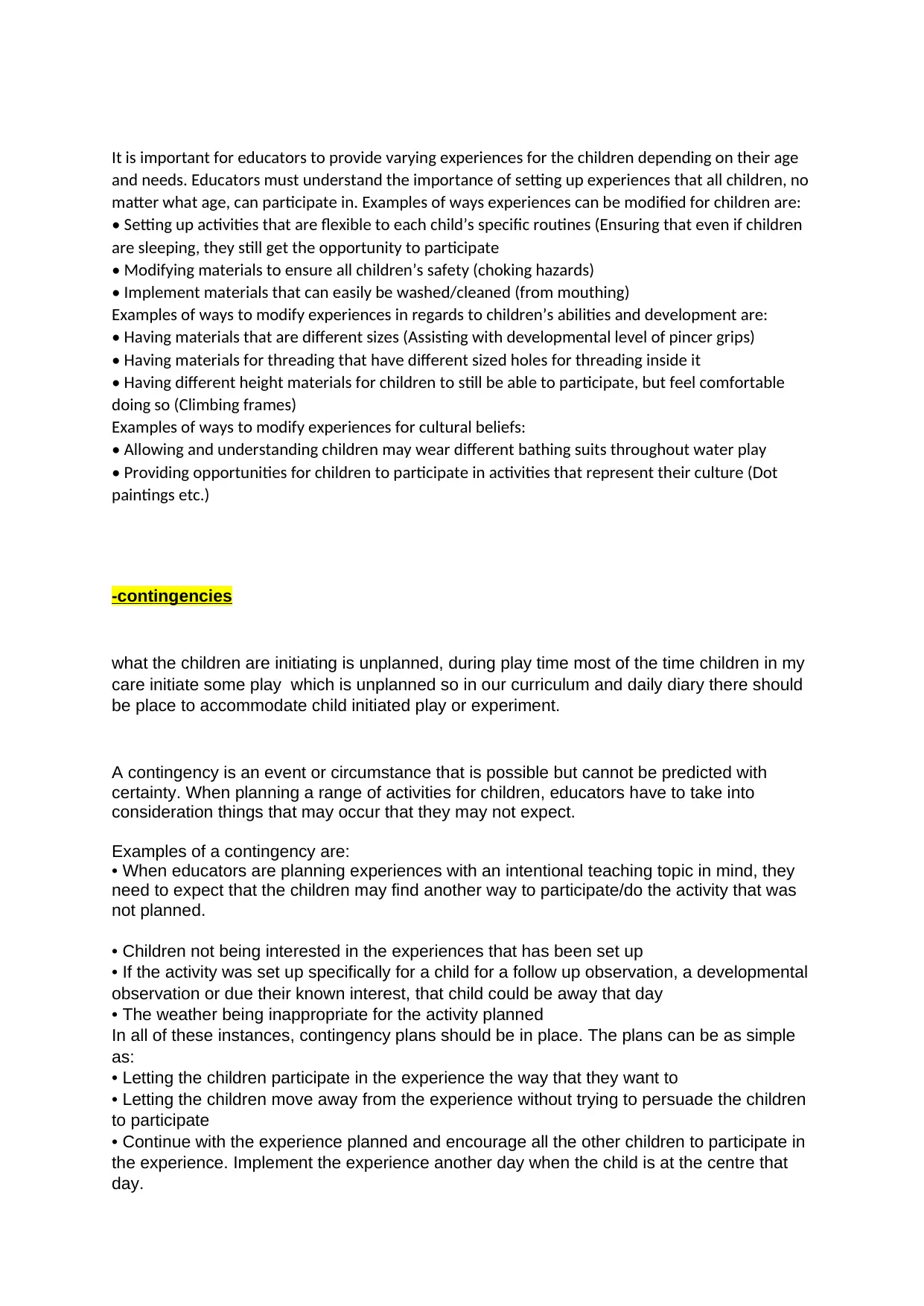
It is important for educators to provide varying experiences for the children depending on their age
and needs. Educators must understand the importance of setting up experiences that all children, no
matter what age, can participate in. Examples of ways experiences can be modified for children are:
• Setting up activities that are flexible to each child’s specific routines (Ensuring that even if children
are sleeping, they still get the opportunity to participate
• Modifying materials to ensure all children’s safety (choking hazards)
• Implement materials that can easily be washed/cleaned (from mouthing)
Examples of ways to modify experiences in regards to children’s abilities and development are:
• Having materials that are different sizes (Assisting with developmental level of pincer grips)
• Having materials for threading that have different sized holes for threading inside it
• Having different height materials for children to still be able to participate, but feel comfortable
doing so (Climbing frames)
Examples of ways to modify experiences for cultural beliefs:
• Allowing and understanding children may wear different bathing suits throughout water play
• Providing opportunities for children to participate in activities that represent their culture (Dot
paintings etc.)
-contingencies
what the children are initiating is unplanned, during play time most of the time children in my
care initiate some play which is unplanned so in our curriculum and daily diary there should
be place to accommodate child initiated play or experiment.
A contingency is an event or circumstance that is possible but cannot be predicted with
certainty. When planning a range of activities for children, educators have to take into
consideration things that may occur that they may not expect.
Examples of a contingency are:
• When educators are planning experiences with an intentional teaching topic in mind, they
need to expect that the children may find another way to participate/do the activity that was
not planned.
• Children not being interested in the experiences that has been set up
• If the activity was set up specifically for a child for a follow up observation, a developmental
observation or due their known interest, that child could be away that day
• The weather being inappropriate for the activity planned
In all of these instances, contingency plans should be in place. The plans can be as simple
as:
• Letting the children participate in the experience the way that they want to
• Letting the children move away from the experience without trying to persuade the children
to participate
• Continue with the experience planned and encourage all the other children to participate in
the experience. Implement the experience another day when the child is at the centre that
day.
and needs. Educators must understand the importance of setting up experiences that all children, no
matter what age, can participate in. Examples of ways experiences can be modified for children are:
• Setting up activities that are flexible to each child’s specific routines (Ensuring that even if children
are sleeping, they still get the opportunity to participate
• Modifying materials to ensure all children’s safety (choking hazards)
• Implement materials that can easily be washed/cleaned (from mouthing)
Examples of ways to modify experiences in regards to children’s abilities and development are:
• Having materials that are different sizes (Assisting with developmental level of pincer grips)
• Having materials for threading that have different sized holes for threading inside it
• Having different height materials for children to still be able to participate, but feel comfortable
doing so (Climbing frames)
Examples of ways to modify experiences for cultural beliefs:
• Allowing and understanding children may wear different bathing suits throughout water play
• Providing opportunities for children to participate in activities that represent their culture (Dot
paintings etc.)
-contingencies
what the children are initiating is unplanned, during play time most of the time children in my
care initiate some play which is unplanned so in our curriculum and daily diary there should
be place to accommodate child initiated play or experiment.
A contingency is an event or circumstance that is possible but cannot be predicted with
certainty. When planning a range of activities for children, educators have to take into
consideration things that may occur that they may not expect.
Examples of a contingency are:
• When educators are planning experiences with an intentional teaching topic in mind, they
need to expect that the children may find another way to participate/do the activity that was
not planned.
• Children not being interested in the experiences that has been set up
• If the activity was set up specifically for a child for a follow up observation, a developmental
observation or due their known interest, that child could be away that day
• The weather being inappropriate for the activity planned
In all of these instances, contingency plans should be in place. The plans can be as simple
as:
• Letting the children participate in the experience the way that they want to
• Letting the children move away from the experience without trying to persuade the children
to participate
• Continue with the experience planned and encourage all the other children to participate in
the experience. Implement the experience another day when the child is at the centre that
day.
Paraphrase This Document
Need a fresh take? Get an instant paraphrase of this document with our AI Paraphraser
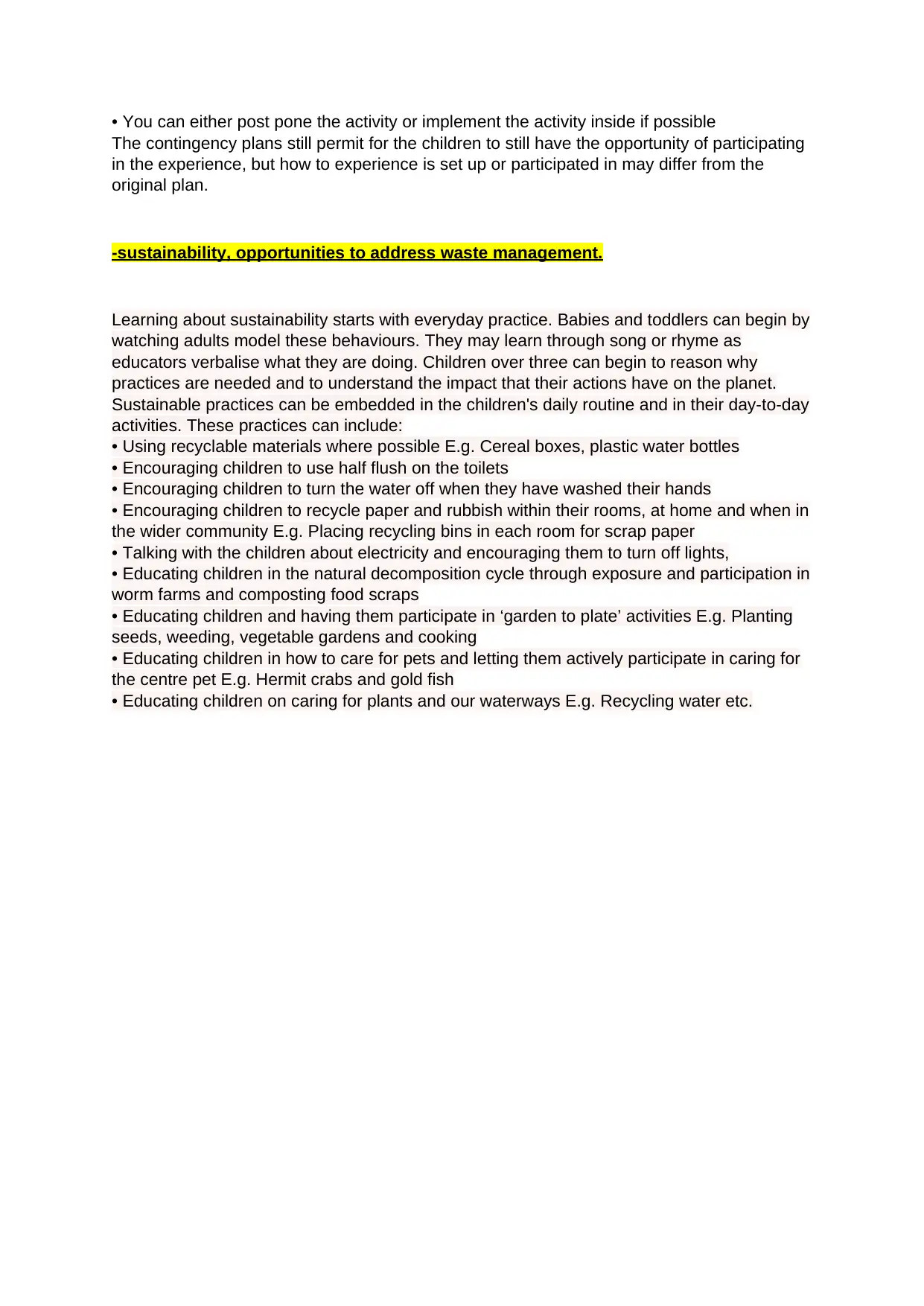
• You can either post pone the activity or implement the activity inside if possible
The contingency plans still permit for the children to still have the opportunity of participating
in the experience, but how to experience is set up or participated in may differ from the
original plan.
-sustainability, opportunities to address waste management.
Learning about sustainability starts with everyday practice. Babies and toddlers can begin by
watching adults model these behaviours. They may learn through song or rhyme as
educators verbalise what they are doing. Children over three can begin to reason why
practices are needed and to understand the impact that their actions have on the planet.
Sustainable practices can be embedded in the children's daily routine and in their day-to-day
activities. These practices can include:
• Using recyclable materials where possible E.g. Cereal boxes, plastic water bottles
• Encouraging children to use half flush on the toilets
• Encouraging children to turn the water off when they have washed their hands
• Encouraging children to recycle paper and rubbish within their rooms, at home and when in
the wider community E.g. Placing recycling bins in each room for scrap paper
• Talking with the children about electricity and encouraging them to turn off lights,
• Educating children in the natural decomposition cycle through exposure and participation in
worm farms and composting food scraps
• Educating children and having them participate in ‘garden to plate’ activities E.g. Planting
seeds, weeding, vegetable gardens and cooking
• Educating children in how to care for pets and letting them actively participate in caring for
the centre pet E.g. Hermit crabs and gold fish
• Educating children on caring for plants and our waterways E.g. Recycling water etc.
The contingency plans still permit for the children to still have the opportunity of participating
in the experience, but how to experience is set up or participated in may differ from the
original plan.
-sustainability, opportunities to address waste management.
Learning about sustainability starts with everyday practice. Babies and toddlers can begin by
watching adults model these behaviours. They may learn through song or rhyme as
educators verbalise what they are doing. Children over three can begin to reason why
practices are needed and to understand the impact that their actions have on the planet.
Sustainable practices can be embedded in the children's daily routine and in their day-to-day
activities. These practices can include:
• Using recyclable materials where possible E.g. Cereal boxes, plastic water bottles
• Encouraging children to use half flush on the toilets
• Encouraging children to turn the water off when they have washed their hands
• Encouraging children to recycle paper and rubbish within their rooms, at home and when in
the wider community E.g. Placing recycling bins in each room for scrap paper
• Talking with the children about electricity and encouraging them to turn off lights,
• Educating children in the natural decomposition cycle through exposure and participation in
worm farms and composting food scraps
• Educating children and having them participate in ‘garden to plate’ activities E.g. Planting
seeds, weeding, vegetable gardens and cooking
• Educating children in how to care for pets and letting them actively participate in caring for
the centre pet E.g. Hermit crabs and gold fish
• Educating children on caring for plants and our waterways E.g. Recycling water etc.
1 out of 5
Related Documents
Your All-in-One AI-Powered Toolkit for Academic Success.
+13062052269
info@desklib.com
Available 24*7 on WhatsApp / Email
![[object Object]](/_next/static/media/star-bottom.7253800d.svg)
Unlock your academic potential
Copyright © 2020–2025 A2Z Services. All Rights Reserved. Developed and managed by ZUCOL.





